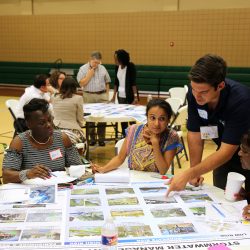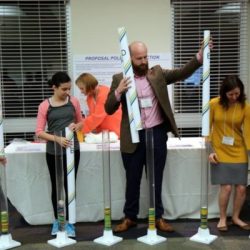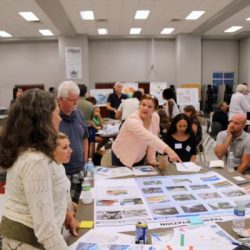NEWS RELEASE
For Immediate Release
Aug. 7, 2017
Media Inquiries:
Janice Lovett, 225.342.1790
Residents across six parishes began to draft adaptation plans after reviewing data, feedback from local communities
Louisiana’s Strategic Adaptations for Future Environments wrapped up parishwide meetings in six coastal parishes Aug. 3 as residents identified ideas and priorities for their respective communities.
The larger summer meetings followed 21 smaller community meetings held in late May and early June that engaged nearly 500 residents in Plaquemines, Terrebonne, Jefferson, St. John the Baptist, Lafourche and St. Tammany parishes. After this latest round, we have engaged nearly 1,500 residents. The parishwide meetings allowed residents to begin the process of drafting strategies based on the feedback generated during the community meeting process. This will lead to the design of specific parishwide adaptation strategies with at least one project, program or policy that would be funded through LA SAFE—a planning initiative coordinated by the Louisiana Office of Community Development’s Disaster Recovery Unit in partnership with Foundation for Louisiana’s Coastal Resilience Leverage Fund.
The LA SAFE planning process will conclude with the final adaptation of a plan for each parish by the end of 2017.
“We have been amazed at how residents have embraced the opportunity to develop a vision for Louisiana’s communities around current and future flood risk,” Mathew Sanders, OCD-DRU’s resilience program and policy administrator, said. “Our team will review all of the feedback provided and come back in the fall to work with residents and stakeholders to continue to refine that vision.”
“While we realize that these are just the first steps on a process that will take us beyond 2017 and hopefully serve as a model for future planning, we’re excited about getting closer to the completion of this particular project,” Liz Williams, director of Foundation for Louisiana’s Coastal Resilience Leverage Fund, said. “Now that we’ve agreed on what a planning process might look like, and identified communities’ needs and opportunities, we’re ready to draft strategies. We’re getting closer.”
Residents can continue to follow the planning process and receive updates on the LA SAFE initiative at LASAFE.la.gov, the LA SAFE Facebook page, Twitter and Instagram (all @livelasafe).
To summarize, here’s what we accomplished so far:
Round 1 (parishwide meetings), early spring: We hosted a parishwide meeting with residents to begin to understand the goals and values within each LA SAFE parish. Considering future flood risks, residents identified what they loved and valued about their communities as well as what they thought could be stronger, improved and safer across three areas including Community and Culture, Economy and Jobs, and Environment and Sustainability. We also identified locations within each parish to host smaller community meetings during round 2 in order to dig deeper into the challenges and opportunities faced within communities across the LA SAFE region.
Round 2 (community meetings), late spring: We met with residents at 21 different meetings throughout the six parishes to identify the needs, strengths, challenges and opportunities at a local level. We began to generate ideas about future growth and ways to address flood risks while also considering what holistic adaptation might look like across social, economic, demographic and environmental systems.
Round 3 (parishwide meetings), summer: The LA SAFE team synthesized the ideas we heard from residents at our community meetings from round 2. Then, we brought them back to the parish level and evaluated these ideas within our parishwide meetings so that residents could begin to prioritize these ideas and tailor them for specific needs. At the meetings, we gave another overview of the entire process, a short recap of the challenges, and then hosted interactive roundtable activities for residents to tell us more about the types of projects, programs and policy recommendations that could make sense for their parish. (See timeline graphic below.)
Round 4 (community meetings), fall: We will come back to the community level with draft strategies and continue to hone in what projects, programs and policy recommendations might look like across the parishes. We look forward to more feedback as we design adaptation strategies to address challenges and opportunities across our coast.
WATCH: Video recap of the process heading into Round 3.
READ: “Take-home” packet with overview of process
# # #
About LA SAFE—LA SAFE is a planning process to develop a common vision with coastal residents intended to guide parish-specific decision-making in coming decades relative to projected flood risks. The Louisiana Office of Community Development’s Disaster Recovery Unit, in partnership with the Foundation for Louisiana’s Coastal Resilience Leverage Fund and the elected leadership of the parish, is coordinating the LA SAFE planning initiative. The planning process is a key step in the implementation of LA SAFE, a $40 million initiative funded by the U.S. Department of Housing and Urban Development. Once plans are developed, the LA SAFE team will use the balance of funds to invest in proposed programs and projects. LA SAFE is a community-focused resilience and adaptation policy framework complementing the state’s Coastal Master Plan. LASAFE.la.gov
About Foundation for Louisiana—The mission of Foundation for Louisiana (FFL) is to invest in people and practices that reduce vulnerability and build stronger, more sustainable communities statewide. FFL’s partnership with the State of Louisiana on the launch of the planning process of LA SAFE builds on FFL’s extensive work in coastal communities and its commitment to equitable and inclusive planning. Working within the Coastal Resiliency Leverage Fund and through the support of the Rockefeller Foundation, the Foundation began work in the summer and fall of 2016 on its LEAD the Coast initiative, which supported Plaquemines Parish residents in the design of their own coastal community engagement and planning process. Since its founding in 2005, FFL has invested $41.5 million in more than 200 mission-critical nonprofit organizations working throughout the state towards rebuilding a better Louisiana. foundationforlouisiana.org




